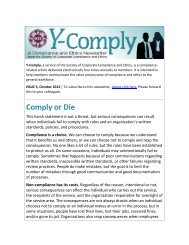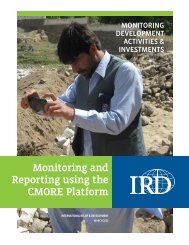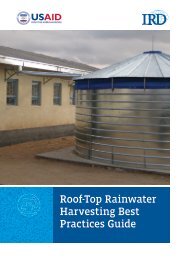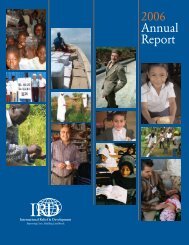Empowering citizens Engaging governments Rebuilding communities
Empowering citizens Engaging governments Rebuilding communities
Empowering citizens Engaging governments Rebuilding communities
You also want an ePaper? Increase the reach of your titles
YUMPU automatically turns print PDFs into web optimized ePapers that Google loves.
“<br />
There were no similar programs. CSP<br />
was historic from the first day. The scale,<br />
the ability, the necessity to work with<br />
the military in a kinetic environment”<br />
—Dar Warmke<br />
2<br />
A complete stabilization package<br />
partner with experience doing this kind of work and a<br />
host of other criteria as well, including a willingness<br />
to work with the military, rapid-start capability, and<br />
flexibility to manage a project that was expected to<br />
grow significantly over its life. On May 29, 2006, it<br />
chose IRD.<br />
USAID looked specifically at two key IRD credentials—<br />
its successful operation of ICAP in Baghdad, where<br />
CSP would be headquartered and where IRD already<br />
had established relationships with local councils<br />
and community leaders; and IRD’s work in Serbia<br />
and Montenegro under the CRDA program. However,<br />
Serbia and Montenegro were not the same as Iraq.<br />
The mission was not remotely on the same scale, and<br />
it was not the same model. IRD’s work in the Balkans<br />
took place in a postwar setting. Iraq, by contrast, was<br />
in full insurrection, and IRD was to work alongside the<br />
US military to provide relief and to help mitigate the<br />
conflict itself.<br />
“There were no similar programs,” said Dar Warmke,<br />
who ran CSP operations for IRD in Basra and, later,<br />
Mosul. “CSP was historic from the first day. The<br />
scale, the ability, the necessity to work with the military<br />
in a kinetic environment. . . . I worked through<br />
the whole Bosnian war, with another organization,<br />
but we were not trying to do stability work at the<br />
same time. There was no clear and hold.” CSP was<br />
unprecedented in its design, and the result was a<br />
stabilization program widely credited by military and<br />
diplomatic leaders for meeting its primary goals—<br />
creating jobs and helping make some of Iraq’s most<br />
devastated <strong>communities</strong> safer. It also stretched<br />
IRD’s capacity, wound down in controversy, and left<br />
many of the organization’s staff simultaneously<br />
praising it for its successes and criticizing it for its<br />
missteps. Ultimately, it offered a blueprint for civilian<br />
participation in COIN operations, and a case study of<br />
the complexities inherent in assisting the military and<br />
militarizing assistance.<br />
Breaking down CSP’s design<br />
As CSP was being designed, a consensus emerged<br />
that high unemployment contributed to <strong>citizens</strong>’<br />
negative perception of local and national government<br />
capacity. CSP focused primarily on males ages<br />
17–35 years because that group made up the highest<br />
percentage of the unemployed, marginalized, and<br />
disaffected and because they were most vulnerable to<br />
joining insurgent groups. By reaching the most-at-risk<br />
members of the population, CSP reasoned, violence<br />
would be mitigated.<br />
“At the end of the day,” said Michele Lemmon, an IRD<br />
senior program officer, “it was all about one thing:<br />
jobs, jobs, jobs. It wasn’t to do charity work, and it<br />
wasn’t to give handouts. It was to help people get<br />
back to what they were doing before.” Jessica Cho,<br />
an IRD field program coordinator, conducted a series<br />
of postprogram interviews with CSP beneficiaries and<br />
local staff. Cho said one of the clearest takeaways<br />
was a basic sense of appreciation for the “number<br />
of jobs that were created in some of these circumstances.”<br />
In most cities, Cho said, CSP was “truly<br />
successful in combining nonskill public works projects<br />
with rehabilitation of basic infrastructure, then using<br />
those successes to promote businesses development<br />
and vocational training. Together, it all led to longer<br />
term jobs and to some sense of stability.”<br />
CSP’s four core programmatic components—infrastructure<br />
and services, vocational training, business<br />
development, and youth engagement—closely<br />
resembled traditional development strategy. Yet the<br />
underlying goal in three of the four areas was that<br />
employment generation intended to:<br />
• Create short-term (fewer than 90 days) jobs through<br />
community infrastructure and essential services<br />
projects,such as rehabilitation of schools, streets,<br />
health clinics, public gardens, soccer fields,<br />
26


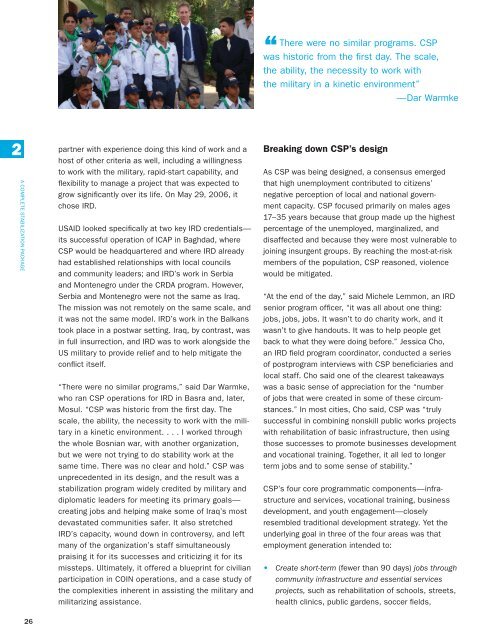
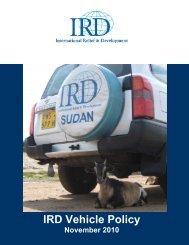

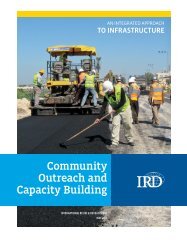
![Guide bonne pratique production d'oignon qualité_VF_4_2411012[1]](https://img.yumpu.com/23506639/1/184x260/guide-bonne-pratique-production-doignon-qualitac-vf-4-24110121.jpg?quality=85)

